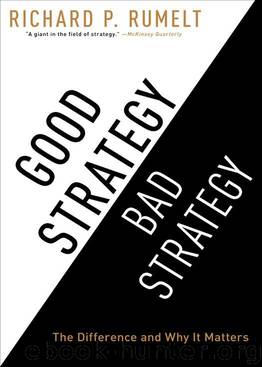Good Strategy Bad Strategy: The Difference and Why It Matters by Rumelt Richard

Author:Rumelt, Richard [Rumelt, Richard]
Language: eng
Format: mobi
ISBN: 9780307886255
Publisher: Random House, Inc.
Published: 2011-07-19T04:00:00+00:00
The problem with engineering growth by acquisition is that when you buy a company, especially a public company, you usually pay too much. You pay a premium over its ordinary market value—usually about 25 percent—plus fees. If you have friendly investment bankers and lenders, you can grow as fast as you like by acquisition. But unless you can buy companies for less than they are worth, or unless you are specially positioned to add more value to the target than anyone else can, no value is created by such expansion.
Corporate leaders seek growth for many reasons. They may (erroneously) believe that administrative costs will fall with size. A poor, but common, reason for acquisitions is to move key executives to the periphery rather than let them go. The leaders of larger firms tend to be paid more. And, in a decentralized company, making acquisitions is a lot more fun than reading reports on divisional performance. In addition to all these reasons, key corporate advisers—investment bankers, consultants, mergers and acquisitions law firms, and anyone who can claim a “finder’s fee”—can earn a king’s ransom by being “helpful” in a major deal.
In 1998, I was retained by Telecom Italia as a special consultant on strategy. Telecom Italia was then the fifth largest fixed-line telecommunications operator and Europe’s largest and most innovative mobile operator. It had been privatized in a series of steps beginning in 1994 and ending in the sale of public shares in 1997.
At that moment the strategic problems facing traditional fixed-line European operators were considerable. Many still earned the juicy gross margins typical of monopoly national carriers, but the future held the possibility of dramatically increased competition and technological change. Deregulation was allowing foreign entry into national markets, and the Internet was blossoming. Companies such as Telecom Italia had large cash flows based on past investments, and a critical issue was where to invest those cash flows. More fixed lines seemed unwise. Optical fiber rings around cities looked promising, but three foreign firms already had plans for regional centers like Milan. Competing against them would simply cannibalize existing business revenue. The Internet was growing rapidly, but income was small—its growth was based on very low prices, much lower than those charged for voice or traditional data traffic.
The chairman and CEO, Gianmario Rossignolo, had been talking about an alliance with Cable & Wireless, a company begun in the nineteenth century as a provider of undersea telegraph links across the British Empire. Nationalized in 1947, it had been reprivatized in 1981 by Margaret Thatcher. Cable & Wireless CEO Richard Brown was an American, brought in to break an internal political logjam that had kept the company operating like a set of independent fiefdoms. Brown had been seeking a major alliance, first flirting with British Telecom, then AT&T, then Sprint. The (fluffy) argument was that telecommunications was globalizing and that there would be value in a global brand.
Brown and Rossignolo had begun their alliance discussions with talk of a series of cross holdings in France, the Caribbean, and other locations.
Download
This site does not store any files on its server. We only index and link to content provided by other sites. Please contact the content providers to delete copyright contents if any and email us, we'll remove relevant links or contents immediately.
Hit Refresh by Satya Nadella(8854)
The Compound Effect by Darren Hardy(8508)
Change Your Questions, Change Your Life by Marilee Adams(7372)
Nudge - Improving Decisions about Health, Wealth, and Happiness by Thaler Sunstein(7242)
The Black Swan by Nassim Nicholas Taleb(6764)
Deep Work by Cal Newport(6563)
Daring Greatly by Brene Brown(6223)
Rich Dad Poor Dad by Robert T. Kiyosaki(6175)
Principles: Life and Work by Ray Dalio(5961)
Man-made Catastrophes and Risk Information Concealment by Dmitry Chernov & Didier Sornette(5647)
Playing to Win_ How Strategy Really Works by A.G. Lafley & Roger L. Martin(5499)
Digital Minimalism by Cal Newport;(5389)
Big Magic: Creative Living Beyond Fear by Elizabeth Gilbert(5351)
The Myth of the Strong Leader by Archie Brown(5237)
The Slight Edge by Jeff Olson(5200)
Discipline Equals Freedom by Jocko Willink(5157)
The Motivation Myth by Jeff Haden(5003)
Stone's Rules by Roger Stone(4857)
The Laws of Human Nature by Robert Greene(4773)
